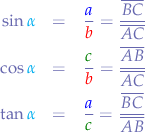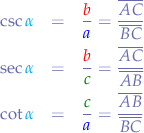Table of Contents
Trigonometric Functions in Right-Angle Triangle
![LaTeX
\begin{tikzpicture}
% grid
\draw[help lines] (-2,-2) grid (2,2);
% origin
%\draw[red, line width=.1mm] (-0.1,-0.1) -- (0.1,0.1)
% (0.1,-0.1) -- (-0.1,0.1);
%\coordinate[label={[red]above:$O$}] (O) at (0,0);
% coordinates
\coordinate[label={[black]left:$A$}] (A) at (-1,1);
\coordinate[label={[black]below:$B$}] (B) at (-1,-1);
\coordinate[label={[black]right:$C$}] (C) at (1,-1);
% triangle
\draw[black, line width=.1mm] (A) -- (B) -- (C) -- cycle;
% alpha
\markangle{A}{B}{C}{3mm}{3mm}{$\alpha$}{cyan}{north}
% braces
%\drawbrace{B}{C}{2mm}{blue}{$a$}{0}{-4mm}{mirror}
%\drawbrace{A}{B}{2mm}{green}{$c$}{-4mm}{0}{mirror}
%\drawbrace{A}{C}{2mm}{red}{$b$}{3mm}{3mm}{}
\end{tikzpicture}](/lib/exe/fetch.php?media=wiki:latex:/img2629e8edfb4cd1bb3a449c3e71fd73aa.png)



Pythagoras (Law of Cosines)
![LaTeX
\begin{tikzpicture}
% grid
\draw[help lines] (-2,-2) grid (2,2);
% origin
%\draw[red, line width=.1mm] (-0.1,-0.1) -- (0.1,0.1)
% (0.1,-0.1) -- (-0.1,0.1);
%\coordinate[label={[red]above:$O$}] (O) at (0,0);
% coordinates
\coordinate[label={[black]left:$A$}] (A) at (-1,1);
\coordinate[label={[black]below:$B$}] (B) at (-1,-1);
\coordinate[label={[black]right:$C$}] (C) at (1,0);
% triangle
\draw[black, line width=.1mm] (A) -- (B) -- (C) -- cycle;
% alpha
\markangle{A}{B}{C}{3mm}{3mm}{$\alpha$}{cyan}{north}
% braces
\drawbrace{B}{C}{2mm}{blue}{$a$}{0}{-4mm}{mirror}
\drawbrace{A}{B}{2mm}{green}{$c$}{-4mm}{0}{mirror}
\drawbrace{A}{C}{2mm}{red}{$b$}{3mm}{3mm}{}
\end{tikzpicture}](/lib/exe/fetch.php?media=wiki:latex:/imge94f792820e480d6d14600c734ea616e.png)

in a right-angle triangle,  such that
such that  :
:

Medians in a Triangle
![LaTeX
\begin{tikzpicture}
% grid
\draw[help lines] (-5,-5) grid (5,5);
% coordinates
\coordinate[label={[black]left:$A$}] (A) at (-3,3);
\coordinate[label={[black]below:$B$}] (B) at (-3,-3.5);
\coordinate[label={[black]right:$C$}] (C) at (3,0);
\coordinate[label={[black]above:$M_{a}$}] (Ma) at ($ (B) !.5! (C) $);
\coordinate[label={[black]below left:$M_{b}$}] (Mb) at ($ (A) !.5! (C) $);
\coordinate[label={[black]below right:$M_{c}$}] (Mc) at ($ (A) !.5! (B) $);
% triangle
\draw[black, line width=.1mm] (A) -- (B) -- (C) -- cycle;
% median for a
\path[draw, black, line width=.1mm, dotted, name path=median from A] (A) -- (Ma);
% median for b
\path[draw, black, line width=.1mm, dotted, name path=median from B] (B) -- (Mb);
% median for c
\path[draw, black, line width=.1mm, dotted, name path=median from C] (C) -- (Mc);
% point
\drawpoint{Ma}{.5mm}{black}
\drawpoint{Mb}{.5mm}{black}
\drawpoint{Mc}{.5mm}{black}
% braces for segment medians a
\drawbrace{B}{Ma}{3mm}{blue}{$a'$}{0}{-5mm}{mirror}
\drawbrace{Ma}{C}{3mm}{blue}{$a''$}{0}{-5mm}{mirror}
\drawbrace{B}{C}{14mm}{blue}{$a$}{8mm}{-14mm}{mirror}
% braces for segment medians b
\drawbrace{A}{Mb}{3mm}{red}{$b'$}{3mm}{5mm}{}
\drawbrace{Mb}{C}{3mm}{red}{$b''$}{3mm}{5mm}{}
\drawbrace{A}{C}{16mm}{red}{$b$}{8mm}{17mm}{}
% braces for segment medians c
\drawbrace{A}{Mc}{3mm}{green}{$c'$}{-5mm}{0}{mirror}
\drawbrace{Mc}{B}{3mm}{green}{$c''$}{-5mm}{0}{mirror}
\drawbrace{A}{B}{18mm}{green}{$c$}{-20mm}{0}{mirror}
% median braces
\drawbrace{A}{Ma}{1mm}{black}{$m_{a}$}{-2mm}{-2mm}{mirror}
\drawbrace{B}{Mb}{1mm}{black}{$m_{b}$}{3.5mm}{-1mm}{mirror}
\drawbrace{C}{Mc}{1mm}{black}{$m_{c}$}{0}{-3mm}{}
% gravity centre
\path[draw, red, name intersections={of=median from A and median from B, by=G}];
\drawpoint{G}{.5mm}{red}
\coordinate[label={[black]above:$G$}] (G) at (G);
\end{tikzpicture}](/lib/exe/fetch.php?media=wiki:latex:/img592898caffbee98aadb1c22118a1d118.png)

Area of a Triangle
![LaTeX
\begin{tikzpicture}
% grid
\draw[help lines] (-2,-2) grid (2,2);
% origin
%\draw[red, line width=.1mm] (-0.1,-0.1) -- (0.1,0.1)
% (0.1,-0.1) -- (-0.1,0.1);
%\coordinate[label={[red]above:$O$}] (O) at (0,0);
%\draw[black,line width=5mm] (-3, {3 * sqrt(3) - sqrt(3)}) -- ((-3,0);
%\node [square,rotate={30},minimum size=10mm] at (-3, {3 * sqrt(3) - sqrt(3)}) [draw] (d2) [orange,fill,text=white] {$d_{2}$};
%\draw[orange,line width=.1mm] (-3, {3 * sqrt(3) - sqrt(3)}) -- (-2,0);
%\draw[orange,line width=.1mm] (-3, {3 * sqrt(3) - sqrt(3)}) -- (0,2);
% coordinates
\coordinate[label={[black]left:$A$}] (A) at (-1,1.5);
\coordinate[label={[black]left:$B$}] (B) at (-1.5,-1);
\coordinate[label={[black]right:$C$}] (C) at (2,-1);
\coordinate[label={[black]below:$P$}] (P) at (-1,-1);
% mark P
\drawpoint{P}{.5mm}{black}
% triangle
\draw[black, line width=.1mm] (A) -- (B) -- (C) -- cycle;
% perpendicular
\draw[black, line width=.1mm] (A) -- (P);
% alpha
\node [square,minimum size=1mm,dotted] at (-1.14,-0.85) [draw] (d2) [black] {};
% braces
\drawbrace{B}{C}{2mm}{blue}{$a$}{0}{-4mm}{mirror}
\drawbrace{A}{P}{2mm}{red}{$h$}{4mm}{0}{}
\drawbrace{A}{B}{2mm}{green}{$c$}{-4mm}{0}{mirror}
\drawbrace{A}{C}{2mm}{red}{$b$}{3mm}{3mm}{}
\end{tikzpicture}](/lib/exe/fetch.php?media=wiki:latex:/img4e592b7654ce547fdf3d14cdf2efefed.png)

Using Heron's formula:

A complete derivation of the Heron formula can be found in the mathematics section on triangles.
Theorem of Ceva
![LaTeX
\begin{tikzpicture}
% grid
\draw[help lines] (-2,-2.5) grid (2,2);
% coordinates
\coordinate[label={[black]left:$A$}] (A) at (-2,2);
\coordinate[label={[black]below:$B$}] (B) at (-2,-2.5);
\coordinate[label={[black]right:$C$}] (C) at (2,0);
\coordinate[label={[black]above:$D$}] (D) at ($ (B) !.52! (C) $);
\coordinate[label={[black]below left:$E$}] (E) at ($ (A) !.4! (C) $);
\coordinate[label={[black]below right:$F$}] (F) at ($ (A) !.4! (B) $);
% triangle
\draw[black, line width=.1mm] (A) -- (B) -- (C) -- cycle;
% line from a
\path[draw, black, line width=.1mm, dotted, name path=line from A] (A) -- (D);
% line from b
\path[draw, black, line width=.1mm, dotted, name path=line from B] (B) -- (E);
% line from c
\path[draw, black, line width=.1mm, dotted, name path=line from C] (C) -- (F);
% point
\drawpoint{D}{.5mm}{black}
\drawpoint{E}{.5mm}{black}
\drawpoint{F}{.5mm}{black}
% braces for segment medians a
\drawbrace{A}{F}{3mm}{green}{$c$}{-5mm}{0}{mirror}
\drawbrace{F}{B}{3mm}{green}{$c'$}{-5mm}{0}{mirror}
% braces for segment medians b
\drawbrace{B}{D}{3mm}{blue}{$a$}{3mm}{-5mm}{mirror}
\drawbrace{D}{C}{3mm}{blue}{$a'$}{3mm}{-5mm}{mirror}
% braces for segment medians c
\drawbrace{C}{E}{3mm}{red}{$b$}{0}{5mm}{mirror}
\drawbrace{E}{A}{3mm}{red}{$b'$}{0}{5mm}{mirror}
% gravity centre
\path[draw, red, name intersections={of=line from A and line from C, by=O}];
\drawpoint{O}{.5mm}{red}
\coordinate[label={[black]above:$O$}] (O) at (O);
\end{tikzpicture}](/lib/exe/fetch.php?media=wiki:latex:/imga89bf7efaa8914ac5294ba4b63052f3c.png)

Theorem of Menelaus
![LaTeX
\begin{tikzpicture}
% grid
\draw[help lines] (-3,-3) grid (5,3);
% coordinates
\coordinate[label={[black]left:$A$}] (A) at (-2,2.5);
\coordinate[label={[black]left:$B$}] (B) at (-2.5,-2);
\coordinate[label={[black]right:$C$}] (C) at (3,-2);
\coordinate[label={[black]south north:$P$}] (P) at ($ (A) !.3! (B) $);
\drawpoint{P}{.5mm}{red}
\coordinate[label={[black]south north:$Q$}] (Q) at ($ (A) !.7! (C) $);
\drawpoint{Q}{.5mm}{red}
\path[draw, black, line width=.1mm, dotted, name path=line from B] (B) -- (C) -- (3,-1);
\draw[red, solid, line width=.1mm, name path=secant] (P) -- (Q) -- (4,-2);
\draw[draw, red, name intersections={of=line from B and secant, by=R}];
\coordinate[label={[black]south north:$R$}] (R) at (4,-2);
\drawpoint{R}{.5mm}{red}
% triangle
\draw[black, line width=.1mm] (A) -- (B) -- (C) -- cycle;
% perpendicular
%\draw[black, line width=.1mm] (A) -- (P);
% braces
\drawbrace{B}{R}{6mm}{blue}{$a$}{0}{-8mm}{mirror}
\drawbrace{B}{C}{2mm}{blue}{$a'$}{0}{-4mm}{mirror}
\drawbrace{C}{R}{2mm}{green}{$r$}{0}{-4mm}{mirror}
\drawbrace{Q}{C}{2mm}{orange}{$s$}{-4mm}{-1mm}{mirror}
\drawbrace{A}{Q}{2mm}{violet}{$t$}{4mm}{1mm}{}
\drawbrace{A}{P}{2mm}{teal}{$u$}{-4mm}{0}{mirror}
\drawbrace{P}{B}{2mm}{olive}{$v$}{-8mm}{0}{mirror}
\end{tikzpicture}](/lib/exe/fetch.php?media=wiki:latex:/img80dba702fd6a78f7cf4b537520701d94.png)

Theorem of Parallels
![LaTeX
\begin{tikzpicture}
% grid
\draw[help lines] (-3,-3) grid (5,3);
% coordinates
\coordinate[label={[black]left:$A$}] (A) at (-2,2.5);
\coordinate[label={[black]left:$B$}] (B) at (-2.5,-2);
\coordinate[label={[black]right:$C$}] (C) at (3,-2);
\coordinate[label={[black]left:$P$}] (P) at ($ (A) !.3! (B) $);
\drawpoint{P}{.5mm}{red}
\coordinate[label={[black]south north:$Q$}] (Q) at ($ (A) !.3! (C) $);
\drawpoint{Q}{.5mm}{red}
\draw[red, solid, line width=.1mm, name path=secant] (P) -- (Q);
% triangle
\draw[black, line width=.1mm] (A) -- (B) -- (C) -- cycle;
% perpendicular
%\draw[black, line width=.1mm] (A) -- (P);
\end{tikzpicture}](/lib/exe/fetch.php?media=wiki:latex:/img8f64a4007f9eac51aae4fa1be429fe7a.png)
If  is parallel to
is parallel to  then:
then:

fuss/mathematics/geometry/shapes/triangles.txt · Last modified: by 127.0.0.1
For the contact, copyright, license, warranty and privacy terms for the usage of this website please see the contact, license, privacy, copyright.



